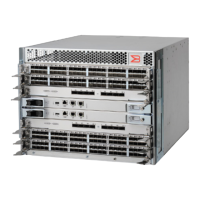53-1002177-19 Hardware Installation Guide
Brocade DCX 8510-4 Backbone Hardware Installation Guide
Cable Management
Requirements and precautions
The cable management finger assemblies are attached to the chassis on either side of the port side of the chassis and
allow for simple cable management. The cable management finger assemblies can be installed without service disruption.
Route the cables across in front of the blades to keep LEDs visible. Leave at least one meter of slack for each fiber-optic
cable to provide room to remove and replace blades.
NOTE
The minimum radius to which a 50 micron cable can be bent under full tensile load is 5.1 cm (2 in.). For a cable
under no tensile load, that minimum is 3.0 cm (1.2 in.).
CAUTION
Before plugging a cable into any port, be sure to discharge the voltage stored on the cable by touching the
electrical contacts to ground surface.
Cables can be organized and managed in a variety of ways, for example, using cable channels on the sides of the cabinet
or patch panels to minimize cable management. Following is a list of recommendations:
NOTE
You should not use tie wraps with optical cables because they are easily overtightened and can damage the
optic fibers.
•
Plan for rack space required for cable management before installing the switch.
•
Leave at least 1 m (3.28 ft) of slack for each port cable. This provides room to remove and replace the switch, allows
for inadvertent movement of the rack, and helps prevent the cables from being bent to less than the minimum bend
radius.
•
If you are using Brocade ISL Trunking, consider grouping cables by trunking groups. The cables used in trunking
groups must meet specific requirements, as described in the Fabric OS Administrator’s Guide .
•
For easier maintenance, label the fiber-optic cables and record the devices to which they are connected.
•
Keep LEDs visible by routing port cables and other cables away from the LEDs.
•
Use Velcro
®
type straps to secure and organize fiber-optic cables.
NOTE
Do not route the cables in front of the air exhaust vent, which is located at the top of the port side of the chassis.
If you are using the Airflow Diversion and Port Side Exhaust Kit with your Brocade DCX 8510-4, there is also an
exhaust vent at the bottom of the port side of the chassis. Use the cable management finger assemblies to keep
the cables away from this exhaust vent as well.
Cable types supported on the FC16-64 port blade
The FC16-64 port blade supports simplified cable management using QSFP cables. Each QSFP cable has four links
internally that run at 16-Gbps speed and the cables come in specific predetermined fixed lengths.
The FC16-64 port blade supports the following types of cables:
•
QSFP to QSFP standard cables
•
QSFP-SFP/LC Break-out/Split-out cables
53-1002177-19
56

